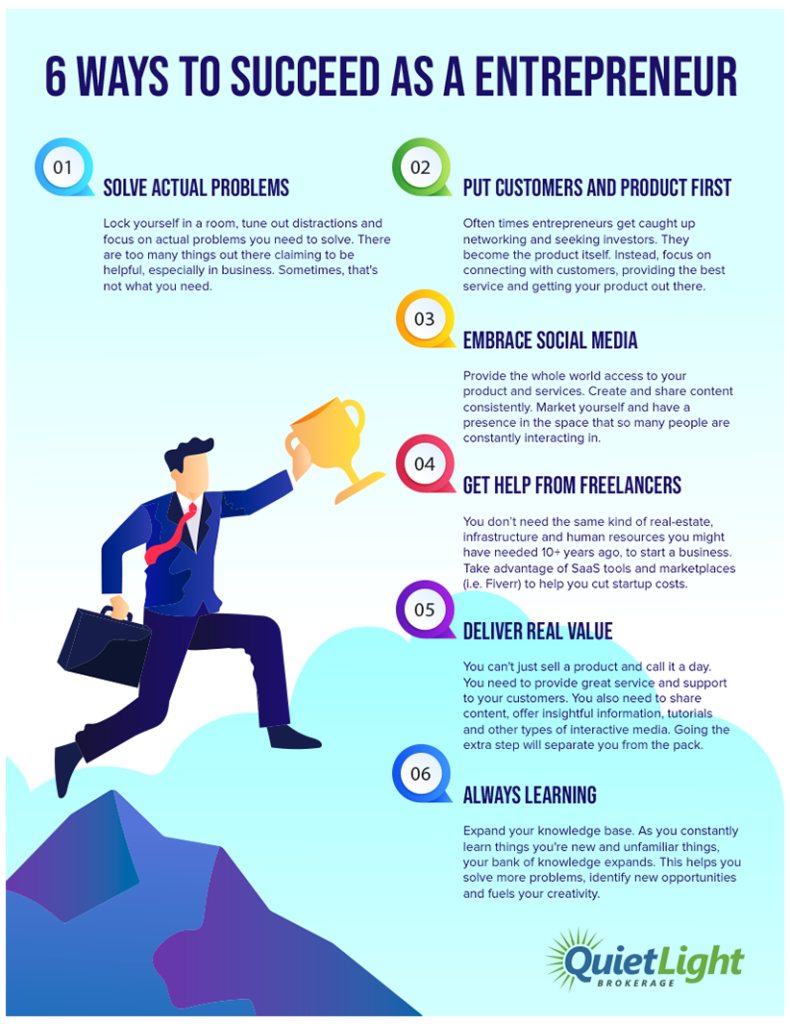Topics:
Never Miss a Beat - Get Updates Direct to Your Inbox
FILTER:


Engineer A More Profitable Exit: How to Think Like Tesla
By Quiet Light
“Exit” might be a four-letter word, but it needs to be part of every entrepreneur’s vocabulary. You’re here to make the most of your business, but how do you architect an exit so crafty, so profitable that it sets you up for life? It all comes down to reverse engineering your exit. Entrepreneurs who suddenly wake up and want to sell their business are in a terrible position to sell their business for 6, 7, or even 8 figures. Friends don’t let friends sell their business for less, so let’s change the course of your future, shall we? Quiet Light’s Joe Valley shares his experience from working with thousands (yes, we counted) of entrepreneurs, including why the hell exit planning matters and 3 steps to engineer a badass exit of your own.
IN THIS POST
How To Plan Your Exit Strategy
Pop The Hood—Why An Exit Strategy Is Important
Engineering Your Exit With 3 Blueprints
Gas Up The Machine For A Profitable Business Exit Strategy
Known for his quirky middle-part, AC current, and his feud with Edison, Nikola Tesla is one of the most celebrated engineers in American history (by the way, the dude was actually from Austria). Although he now has a crazy car company that shares his moniker, Tesla was famous for his futuristic, out-there ideas. In other words, he marched to his own beat and forged forward based not on what other people told him to do, but what he knew was right.
Business owners have to do the same. You can’t become a sheeple, following what everyone else is doing. If you did that, you’d be chained to a desk for 40 hours a week answering to a boss. Gross.
No, business owners have to think differently. And since you’re likely in the business of making money, you can’t think like 99% of business owners. You want to be part of the 1% of biz owners who find the giddy-up-and-go for their business; it’s time to turn it into a powerful economic engine.


It sounds counterintuitive, but the best way to financial freedom through your business is to sell that sucker. Enjoy an early retirement, use those funds for another venture, or sit on your ass and do nothing all day with that money—we aren’t here to judge.
How To Plan Your Exit Strategy
The thing is, you can’t earn life-changing money from your business exit if you pop out of bed one day and say, “Aha! I want to sell my business right now!” We wish it worked that way, but like unicorns and civil internet arguments, it’s just not realistic.
Like smarty-pants Tesla, you’ve got to change the way your brain thinks and look at your business as a machine in need of fine-tuning. If you don’t like what the machine is producing, you wouldn’t sell it as-is, right?
Of course not!
Any self-respecting engineer would go back to the drawing board, make adjustments, and change the machine. Instead of cranking out lumps of coal, with the right tweaks and planning, your business can churn out diamonds.


Listen to the Source of this Post:
This blog post is based on a podcast episode that we recently recorded. Listen to the full episode here:But you’ve got to make a plan to get there first. Instead of suddenly deciding to sell one day, you’ve got to evaluate your business ahead of time. (I mean, you can still sell your biz with 6 – 12 months of planning, but the more time on your side, the better.) Now’s the time to get ahead of your business exit, even if you have zero intention of exiting in the next year or so.
Instead of saying “How much can I sell my business for?”, you should be saying, “I want to build wealth by selling my business for $X. I’m going to do that in four years.” That doesn’t seem like a big jump, but each approach has a different attitude behind it, and attitude matters when you’re trying to engineer a wealth-generating machine, friend.
Pop the hood on your business machine, a la the great Tesla, and get your safety goggles—we’re diving into why you’ve got to reverse-engineer a business exit and how to do it in 3 steps.


Pop The Hood—Why Exit Strategy Is Important
“I don’t caaaare about exit planning,” you might think, “I just want to get rid of this damn business. I can’t deal with one more to-do; exit planning sounds like a waste of time right now.” I hear ya. You’re tired, you’re sick of the emails, and you just want to take a nap. A break from your business sounds wonderful.
But you know what also sounds wonderful? Planning your exit for 6, 7, or even 8 figures. The key is to start planning for an exit down the road right now, whether it’s one or seven years away.
“Sometimes entrepreneurs just don’t want to hear it. The idea of exit planning is so beyond what they’re trying to do,” Joe says. After all, you’re trying to keep the wheels on the bus. You’re so focused on the daily minutiae of logistics, marketing, and management that an exit plan feels like one heavy load that will break down your machine. It’s tempting to say, “Screw this,” and sell your business for a low amount.


But you shouldn’t settle. No matter how hard it is, exit strategy is a smart move for you. Hell, Quiet Light’s Joe Valley knows this better than anyone. Years ago, he was actually a Quiet Light client.
He wanted to get rid of his health supplement business, but after a few calls with Mark Daost, he realized the business had so much to offer. If Joe left now, he would leave hundreds of thousands on the table. That’s lottery money, baby, and it’s a lot more certain than buying a scratch-off ticket. So Joe stuck with it and garnered an insane exit that set him up for success.
Your business has value. As the engineer of this zany little creation, you’re honor-bound to optimize this machine to best serve you. That means instead of setting the machine on fire and walking away, you polish its gears and set yourself up for early retirement.


Engineering Your Exit With 3 Blueprints
Tesla’s savvy designs all started with one thing: the humble blueprint. You also need a blueprint to reverse engineer your way to an awesome business outcome for more money. Joe shared his 3 favorite blueprints to help businesses craft the perfect exit strategy. Check ‘em out to redesign your business engine for a juicier exit.
1. Cultivate An “Exitpreneur” Mindset
Picture this: good old Joe gets an email from an entrepreneur asking for advice on selling an online business. Joe says, “Cool! You need to do X, Y, and Z to make that happen.” Before you know it, the entrepreneur is saying they’re:
- Too busy to think about exit planning
- Adding SKUs and need more data before exiting.
- Not ready to sell yet.
Mind you, these aren’t pipsqueak businesses operating out of lemonade stands. These are folks taking $600,000 home in seller’s discretionary earnings. Another dude was earning $10 million in revenue, but with a 25% decline. Even then, he wasn’t “ready” to exit.


“They’re not ready to exit, but I want them to set a financial goal. I don’t care if it’s years away: set that goal anyway,” Joe says. The thing is, you don’t have to exit your business tomorrow. In fact, like arguing politics with your in-laws, that’s a universally bad idea. The issue isn’t that these entrepreneurs aren’t ready to sell—they are. It’s actually a mindset problem.
Are you an entrepreneur or a badass exitpreneur?
Entrepreneurs Versus Exitpreneurs
Entrepreneurs have the knowledge to run their own business. They’re savvy and experienced, but they only know how to run a business. But when it comes to leaving that business, they’re inexperienced at the wheel. It’s big, it’s scary, and it flies in the face of your entrepreneurial instincts. That means you hunker down, hoarding your biz until it’s lost a lot of sellable value. Womp womp.
On the other hand, exitpreneurs know how to run a business, but they also know how to exit it. From the start, exitpreneurs make a plan to run their business in a way that boosts its sellable value. Translation: you put up with the crap just long enough to generate wealth on your exit. “They have a mindset of planning their exit. They got an education and made a goal,” Joe adds.


Which one are you? The idea is to shift your mindset from being just an entrepreneur to becoming an exitpreneur. That starts with planning to sell your business, not waking up one day and deciding to sell it. After all, a good engineer doesn’t slap something together. She takes her time building it thoughtfully.
How To Become An Exitpreneur
Mindset changes sound fluffy and dumb, but don’t skip this. If you plunge headfirst into an exit without your heart in the right place, your machine is going to putter and die in a ball of flames.
Not sure how you can become an exitpreneur? Try this:
- Make a plan to sell your business. Try to do this with at least 12 months’ lead time, if you can.
- Envision life post-exit. What does it look like? What are you enjoying? What’s different?
- Connect with other exitpreneurs. You are who you know, after all.
- Daydream about all the cool shiz you can build when you aren’t in this business.
- Get a coach! An impartial coach is a great way to adjust crappy thought patterns that hold you back.
The difference is that exitpreneurs plan way ahead. It’s like running a 5K: you know that beer and snacks are at the finish line, which helps you push through and run faster (even though running sucks). An exitpreneur mindset will help you become the engineer of your own fate.


And a good exitpreneur knows that today is the right time to make changes, not in 3 years. Don’t hesitate—you’re ready now.
2. Plan Before You Profit
Remember traveling before the modern conveniences of Google Maps? You probably searched good old MapQuest and printed the directions so you could get to Blockbuster. You didn’t magically know where Blockbuster was; you had to come with a goal (get to Blockbuster to rent Weekend At Bernie’s for the tenth time) and MapQuest gave you a list of steps to get to your goal.
Thankfully, the Blockbuster/MapQuest era is dead and gone, but you’ve still got to know where you’re going to get somewhere. Business exit strategy is no different, boss. You’ve got to decide where you want to be, and then outline the steps to make that happen. It’s called backward design. “Reverse engineer the path from where you are today to that exit,” Joe says.


In the world of business exits, that sounds like, “I want to sell my business for 1.2 million dollars in 4 years.” That’s pretty dang specific, isn’t it? That’s all well and good, but to get to a $1.2 million value, you’ve got to understand which mechanisms are going to create value for your brand. Even if you don’t think you’ll be emotionally ready to sell in 4 years, you owe it to your future self to become a freakin’ business genius in the meantime.
And maybe you don’t end up selling in 4 years after all. You’re allowed to do that! The Business Police isn’t going to throw you in the gulag for changing your mind. Tesla reworked a crapton of his inventions, and that meant changing his mind. As the engineer of your business exit strategy, you’re allowed to adjust.


So yeah, you need a financial goal for the future right now. Unlike a clingy spouse with daddy issues, this is an easy commitment to change down the road. Once you reach $1.2 million in value, you can keep going. Hell, set a new goal! Take over the world! Do what you want!
“If you’re not ready to sell, you can always move on to a new goal,” Joe says. But for the love of Pete, have a goal. Always make a plan so you can profit off your business exit strategy.
How Do I Make A Business Exit Plan?
Easy! Joe recommends that you:
- Decide how much money you want when you exit. What’s reasonable? What’s going to support your lifestyle? What do you want that cheddar to fund, and for how long?
- Look at where your biz is right now. “You’ve got to see where you are today,” Joe adds. If you want a $1.2 million biz but you’re at $500,000 right now, you know you need to increase by $700,000. Congratulations: you’ve just identified your gap.
- How are you going to cross that gap? What actions will boost your value by $700,000? Is it a new product? Updating your logistics? Diversifying through acquisitions?
- Based on how much you need to earn and what you need to do to rake in that dough, set a goal date. You very well could go from $500,000 to $1.2 million in 4 years, but be realistic.
From there, you should be able to say, “I want to earn $1.2 million from my business in 4 years,” and have a solid path forward. The next step is to do the thing. Don’t let that blueprint languish on your table! Put that sucker to work. You’ll only have a profitable business exit if you actually implement your plan.


3. Know What’s Feasible For You
Tesla didn’t engineer anything that he wasn’t confident in building. He didn’t push himself to build, say, rocket-powered baby rattles. He was a mad scientist, for sure, but he wasn’t loony.
As much as we all love cold, hard cash, healthy business exits aren’t just about the money. You’ve got to engineer an exit plan that’s perfect for you. And hey, what’s perfect for you isn’t going to be someone else’s cup of tea.
Problem is, businesses are like people. They change over time, and the sweet, funny little business you started out with can become a profitable buzzkill that’s not fun anymore.
Lots of founders are addicted to founding awesome businesses, but struggle to take it to the next step. Business requires changing to grow, and that means trying new ideas, adding more people, and losing a few hours of sleep. But what do you do when the biz reaches a crisis point?


That’s the danger of outgrowing your business. “One of the goals of exit planning is to not allow the business to outgrow its founder,” Joe says.
For example, once upon a time, Joe did radio advertising (this was around the time Blockbuster was hot shiz). Joe’s media agency could have grown, but he would have had to add more and more people, increasing overhead. Joe doesn’t like managing a huge team of people, and realized he was no longer a fit for the business’s future.
It’s okay to sell when everything’s going well. It’s okay to look in the mirror one day, not recognizing the business you’ve built. It’s okay to exit and start over.
If your products are selling like hotcakes on Amazon, it can feel like you’ve got it made. But what happens when the product takes over your house? Or you can’t spend time with your kids anymore because you’re always working?
Exit at the right time for you. Sell your online business to someone who has the skills and passion to take this puppy to the next level. As for you, you get to ride into the sunset with a fat stack of cash and your sanity intact.


Know thyself, boss. Don’t make a plan to be in your business for another 10 years if you don’t want to scale, or add more people, or create new products.
Gas Up The Machine For A Profitable Business exit strategy
You don’t need to be as tech-savvy as Tesla or have an MIT engineering degree to master reverse engineering your business exit. It does help to switch to an exitpreneur mindset, create a concrete goal, and design a business exit strategy that works for you (not for other people).
Don’t wake up and decide to sell your business. Even if you’re not ready to leave, set up a financial goalpost and start moving towards your exit. And when you do reach that goal and you’re not ready to sell—who cares? Celebrate and keep going if you want. But you can’t get to a better place unless you plan what the hell your business will look like moving forward.
A 2 AM last-call at the bar is your time to settle; right now is not. Get the fat business exit you deserve and gallop into the sunset, counting your hundreds of thousands of extra dollars. Enjoy that freedom, boss. You earned it.





